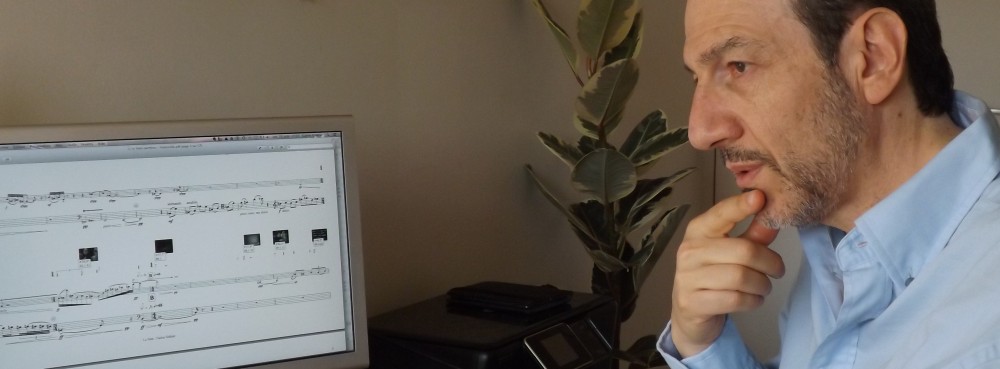Georges Méliès, The “Magician of Cinema” (2011)
Music for silent movies of Georges Méliès, for 7 instruments (fl, cl sib/bs, sax sop/bar, hn, vln, cb, perc) & électronics tape.
Commissioned by the City of Geneva. Production DRAMA/Sillages, in coproduction with Césaré (National Centre for Musical Creation), Reims.
’A conjurer who put the cinematograph in a hat and pulled out cinema.’ (Edgar Morin)
Three short films by Georges Méliès interspersed with four little films, with accompanying music for seven musicians, electronics and conductor. The show is organized around three films combining science-fiction and magic.
Three short films by Georges Méliès interspersed with four little films.
– L’Homme-orchestre (3′) (The One-man band, 1900)
– Le Voyage dans la lune (13′)(A Trip to the moon, 1902)
– Nain et géant (1′) (The Dwarf and the giant, 1901)
– Le Royaume des fées (16’30”) (The Kingdom of fairies, 1903)
– L’Illusionniste double et la tête vivante (1’20”) (The Triple Conjurer and the living head, 1900)
– Voyage à travers l’impossible (21′) (The Impossible Voyage, 1904)
– Dislocation mystérieuse (2′) (Extraordinary Illusions, 1901)
Concert comments
‘The show is organised round three films mixing science fiction and extravaganza : Le Voyage dans la lune, Voyage à travers l’impossible (voyage to the centre of the sun) and Le Royaume de fées. The first two films complement one another symmetrically : the first voyage is made left to right, the second right to left. Between these two large interstellar voyages, we find ourselves with a fanciful fairy tale brimming with imagination.
These long short features (lasting 12, 16 and 20 minutes) are punctuated by very short films (2-3 minutes) in which we see Méliès direct himself, giving free rein to the magic of special effects : multiple exposures, matte shots, frame-by-frame shooting… They attest to the discovery of the new technical means permitted by cinema at its birth.
The composition of the music remains closely linked to the image and the cinema discourse while maintaining its own grammar and freedom. It follows the plot, fading or accentuating with musical gestures that are sometimes exuberant, in keeping with the acting, which evokes mime more than theatrical declamation of the period.
Here, mixing instrumental sounds and those produced by electronic synthesis or transformation takes on its full sense, echoing the approach of this enthusiast of disco- very, innovation and new technologies.
My idea was to write ‘light’, playful music that plays between real sound and transformed sound, motifs, rhythm and colours. It endeavours to be close to Méliès’s art, above all his intentionality, open-mindedness and humour, taking the imaginary, wonder and invention as sources of inspiration.
One could establish a progression – a historic lineage – as concerns my relation to the image and handling of musical time. I have always adhered to Norman McLaren’s thought that ‘it is of little importance what moves; what is important is how it moves’. The Canadian filmmaker considered himself the spiritual son of Méliès, to whom we owe the remark : ‘The question is to understand what cinema must be… especially movement’.
Méliès, like the Symbolists, felt that art had value only if based on magic and music. He conceived the film as a means of personal expression, which gave me the free- dom to do as much with the musical composition for this show.
What could be closer to the desired goal in my work than his idea of ‘showing what does not exist’ : creating a new music for these marvellous films, making heard (a century later) what does not yet exist ?’
Carlos Grätzer (march 2011)
Presse
Minuit, l’heure de Méliès
Il y a plus d’un siècle, Georges Méliès inventait les effets spéciaux du cinéma. Réalisés à la main avec pochoirs, caches et transparences, ils n’ont pas pris une ride à l’ère de l’imagerie générée par ordinateur. Vendredi à l’Alhambra, peu avant minuit, Méliès…célébrait les 150 ans de sa naissance dans le cadre de la Fête de la musique…
…Commandée tout exprès pour l’occasion, la partition de Carlos Grätzer colle parfaitement à l’imagination visuelle du pionnier du septième art. Entre «sous-titrage» sonore et contrepoint abstrait, entre bruitages électroniques et alchimie instrumentale, la musique de Carlos Grätzer (interprétée par l’excellent Ensemble Sillages) souligne le dynamisme abrupt du montage, la force des apparitions fantastiques. Méliès en sortait plus actuel que jamais.
Tribune de Genève 19/06/2011
Vidéo exerpts
Past performances (non-exhaustive)
Fist Performance:
17/6/2011 – Ensemble Sillages (Sophie Deshayes, flûte ; Jean-Marc Fessard, clarinette ; Hélène Colombotti, percussion ; Vincent Leterme, piano ; Nadine Bodiguel, violon ; Gilles Deliège,alto ; Séverine Ballon, violoncelle. Direction, Renaud Déjardin) – Théâtre de l’Alhambra – Genève, Suisse
À l’occasion du 150e anniversaire de la naissance de Georges Méliès
11/10/2011 – Ensemble Sillages – Le Quartz, Grande Salle – Brest



